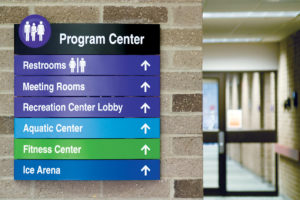Municipal Ordinances Restrict Commercial Signage
In the U.S., there exists a growing trend of municipalities passing ordinances to restrict commercial signage. In some cases, these ordinances place limits on how much of the exterior of a building or the expanse of windows can be taken up by signage. In other cases, ordinances restrict the use of digital signage along highways, based on claims that such signage is linked to traffic accidents. Exterior signage is affected by these ordinances, but interior signage isn’t exempt, either. What’s driving this trend, and what are the ramifications?
Aesthetic Concerns
One of the motivating factors for commercial signage ordinances is aesthetic concerns. Some ordinances seek to regulate the height at which signage is mounted and to limit the use of skyline signage. Other ordinances are aimed at curbing what some people feel is excessive signage, or signage that covers too much of the surface areas of buildings and windows. Billboards are often restricted or banned by such ordinances. Many business owners, however, feel that signage ordinances go too far and have a negative impact on their businesses, since the ordinances restrict their ability to advertise.
Traffic Safety
Sometimes municipal ordinances seek to curb signage along highways, particularly digital signage, citing a wish to improve traffic safety. Some people claim that the signage distracts motorists and makes them more prone to accidents. People who oppose these ordinances, though, claim that a disconnect exists when it comes to digital signage. Indeed, digital signage is often used on freeways to alert motorists to detours necessitated by construction and to inform motorists how much time they will need to reach a particular destination or exit. Business owners note that digital signs are used to promote health and safety in a variety of ways, so in their opinion, ordinances that restrict commercial digital signage on the basis of safety concerns are misguided.
Commercial Speech
Lawsuits filed as a result of ordinances that restrict signage often cite the restrictions as violations of the First Amendment. Indeed, commercial speech, of which commercial signage is a part, has been clearly recognized by the U.S. Supreme Court as protected by the First Amendment. That strategy, however, does not fit every situation. Ordinances can be repealed on the basis of First Amendment violations only if the restrictions pertain to the actual content of the signage, that is, its speech. If the ordinance can be demonstrated to serve some other purpose, then it might well stand.
Enforcement of the Ordinances
Another objection to ordinances that restrict commercial signage is that enforcement of the ordinances isn’t consistent. Indeed, in a large urban area, it’s difficult if not impossible to enforce the ordinances evenhandedly. What that means for day-to-day business activity is that some businesses, perhaps due to their location or some other arbitrary factor, bear the brunt for violating ordinances in some small measure, while other businesses in different locations are left alone to violate the ordinances more flagrantly. If severely restrictive signage ordinances can’t be fairly enforced, some people argue, then why have them?
So the question arises: what about the future? Clearly, there are strong feelings on both sides. Business owners want to obey the laws, but they’re frustrated when they feel their hands are tied when it comes to deploying commercial signage, which is crucial not only to marking their location but also to advertising locally and branding their businesses. Small businesses are particularly vulnerable to effects of municipal ordinances that severely restrict commercial signage. Nobody wants a surplus of signage to compromise aesthetics and safety, but well-designed, well-placed signage has a demonstrated value to members of any community, business owners and patrons alike, and representatives of municipalities would do well to thoroughly study the available research in this regard.

